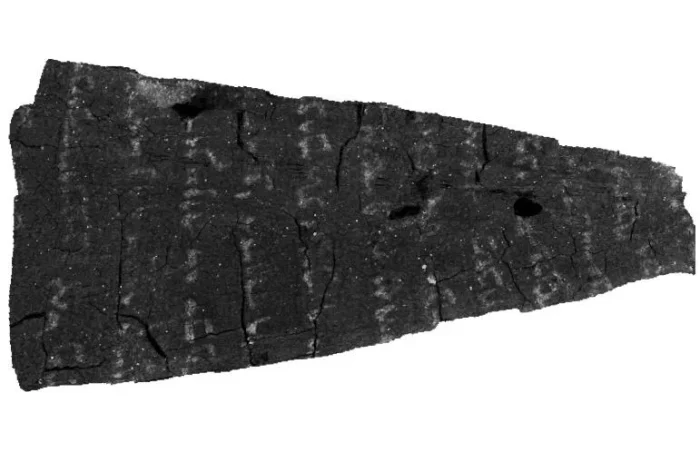Reading the Unreadable: How Modern Technology is Restoring Ancient Biblical Texts
Imagine holding an ancient scroll that hasn’t been read in over a thousand years—a manuscript so fragile that unrolling it would reduce it to dust. For generations, the content and text contained within such ancient manuscripts have been locked away unusable, their secrets essentially lost due to the impossibility of reading it. Scholars, historians, and Bible enthusiasts have long yearned to access these lost pieces of history that hold the potential to deepen our understanding of the biblical text. Over the last decade, technology has revolutionized the field and allowed many of these texts to be read.

The Challenge of Damaged Scrolls
Textual criticism has always faced the daunting task of piecing together incomplete or damaged manuscripts. Traditional methods often required physical handling of fragile documents, risking further deterioration. In some cases, texts were so badly damaged that attempting to open or read them was impossible without causing irreparable harm. This left scholars with tantalizing fragments of history just out of reach, their secrets locked away within charred or brittle scrolls.
A Technological Breakthrough: Reading the Unreadable
The advent of advanced imaging techniques has revolutionized this field. Scientists and engineers are now employing sophisticated methods such as X-ray phase-contrast tomography, multispectral imaging, and machine learning algorithms to virtually “unroll” and read texts that were once considered lost forever. Here are two examples of how this new technology has been recently used.
The Herculaneum Scrolls: A 2,000-Year-Old Library Revealed
One of the most remarkable examples of this technological marvel involves the Herculaneum scrolls. Buried beneath volcanic ash during the eruption of Mount Vesuvius in 79 AD, these scrolls were carbonized and rendered unreadable—until now. A recent breakthrough was achieved by a team of researchers who successfully read the hidden text within these ancient scrolls without physically opening them.
Using advanced imaging techniques and artificial intelligence, the team was able to detect the faint traces of ink on the rolled-up scrolls. The University of Kentucky’s engineering department played a pivotal role in this discovery. As reported in this article, their innovative approach has unlocked a treasure trove of historical and literary works, potentially including lost philosophical texts and perhaps even early biblical manuscripts.
The En-Gedi Scroll: A Burned Hebrew Text Resurrected
In another astonishing feat, a 1,500-year-old Hebrew scroll from the En-Gedi site was digitally restored after being burned and unreadable for centuries. Scientists used micro-computed tomography to create a high-resolution 3D image of the scroll’s interior layers. By virtually unrolling the scroll, they could read the text without touching the delicate artifact.
The Smithsonian Magazine details this incredible achievement in their article. The En-Gedi scroll was found to contain passages from the Book of Leviticus, making it the oldest known copy of a Pentateuchal book after the Dead Sea Scrolls (dating roughly to the time of Jesus). Furthermore, the content of the scroll closely aligns with what becomes known as the Masoretic Text (the Hebrew text which is behind many of our English translations today). Practically, this means that from the evidence we now have, we can say that Jesus’s copy of Leviticus would read the same as the Leviticus we hold in our hands!
Implications for Biblical Studies
These technological advancements have profound implications for biblical scholarship and our understanding of history. By unlocking texts that were previously inaccessible, scholars can:
- Verify Historical Consistency: Comparing newly read texts with existing manuscripts can affirm the reliability and consistency of biblical texts over time.
- Discover Lost Works: There’s potential to uncover texts that were thought to be lost forever, including commentaries, interpretations, and perhaps even entirely new works that can shed light on historical events and theological developments.
- Enhance Cultural Understanding: Some of these texts provide context about the societies in which they were written, offering insights into the cultural, political, and religious landscapes of ancient civilizations.
The Future of Textual Criticism
The blending of technology and textual studies exemplified in these projects heralds a new era for textual criticism. As imaging techniques become more sophisticated and accessible, we can expect:
- Increased Collaboration: Interdisciplinary teams of scientists, engineers, and scholars will continue to push the boundaries of what’s possible.
- Preservation of Artifacts: Non-invasive methods ensure that priceless artifacts remain intact for future generations.
- Educational Opportunities: Digital reproductions of texts can be shared globally, providing educational resources for students and enthusiasts worldwide.
Conclusion
The restoration of texts from the Herculaneum scrolls and the En-Gedi scroll that were once thought to be lost forever exemplifies the incredible potential of modern technology to bridge the gap between past and present. For Bible students and scholars, these developments are not just exciting—they’re transformative. They open up a whole new world of possibilities and give us a pathway to better appreciating the biblical context. Furthermore, they give us more evidence for confirming that the Bibles we read, both Old and New Testaments are indeed the revealed Word of God. And that is something to rejoice in!
